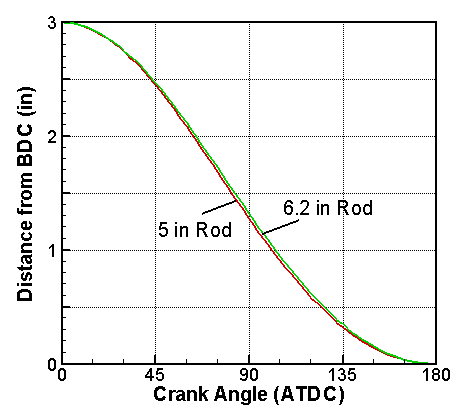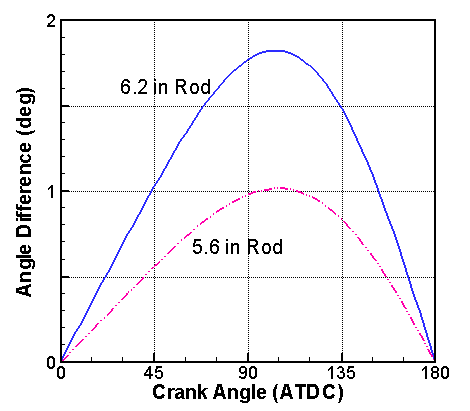Rod Length and Cam Timing
Small block V8's seem to like fairly wide lobe separation angles (defined in Cam Basics). This page explains why. In the old days, valve timing wasn't specified using crank angles as it is today. Valve timing was specified using piston position. For the Model T you could purchase a measuring tool for measuring piston position. Piston position makes more sense, even though it is more cumbersome for the mechanic.

 The
graph at the left shows the piston position as a function of
crankshaft angle for two cases. Both cases have a three inch
stroke. One has a rod length of 5.0 inches, the other has a
rod length of 6.2 inches. You will note that in both cases the
upper and lower portions are asymmetric. The position at the mid
angle is significantly below the mid position. The curves are
very close to one another, but there are differences as shown in the
second graph on the right. The second graph shows the
difference in crankshaft angle that will give the same piston
position, i.e. the horizontal difference between the two curves.
The second graph shows the first case and a second case comparing a
5.6 inch rod to a 5 inch rod.
The
graph at the left shows the piston position as a function of
crankshaft angle for two cases. Both cases have a three inch
stroke. One has a rod length of 5.0 inches, the other has a
rod length of 6.2 inches. You will note that in both cases the
upper and lower portions are asymmetric. The position at the mid
angle is significantly below the mid position. The curves are
very close to one another, but there are differences as shown in the
second graph on the right. The second graph shows the
difference in crankshaft angle that will give the same piston
position, i.e. the horizontal difference between the two curves.
The second graph shows the first case and a second case comparing a
5.6 inch rod to a 5 inch rod.
Suppose you have a cam with timing of 15-55-55-15. The duration is 250 for intake and exhaust, lobe separation is 110, timed straight up (no advance or retard). The 55 BBDC (and ABDC) corresponds to 125 degrees in the graph. With the 5 inch rods, the position is 0.486. The 6.2 inch rods reach this position at 53.3 BBDC. For the intake closing (or exhaust opening), the same piston position is reached at 15 and 15.3 ATDC degrees for short and long rods, respectively. To achieve the same timing by piston position with the long rods, the angular timing would have to be changed to 15.3-53.3-53.3-15.3. The duration is reduced slightly to 248.6 and the lobe separation decreased to 109.0.
In general, to achieve the same piston position timing with short and long rods, the engine with longer rods should have a cam with slightly less duration and with a smaller lobe separation angle.